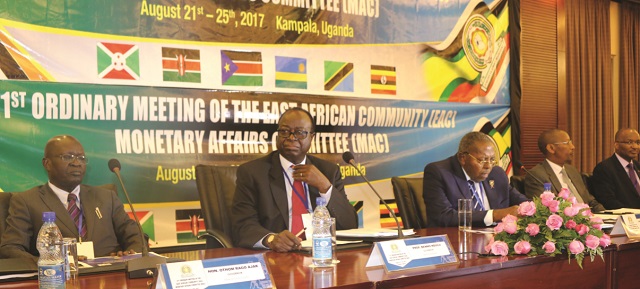
The economic rescue initiatives can only succeed without political interference
Kampala, Uganda | ISAAC KHISA | How can central banks in the East African Community boost private sector credit that has since last year slowed down? That was one of the issues that the Central Bank Governors in the region deliberated on during the 21st Ordinary East African Community (EAC) Monetary Affairs Committee held in Kampala on Aug. 25.
Emmanuel Tumusiime-Mutebile, the Governor of Bank of Uganda and the current chairperson of the Monetary Affairs Committee told his guests that they have attained a lot of progress towards the operationalisation of the East African Common Market protocol but there have been a number of emerging issues which pose serious challenges to our integration efforts.
“Some partner states have faced a slowdown in economic growth, both in the growth of private sector credit and the economic activities coupled with an increase in the non-performing loans,” Mutebile said.
He said further reduction in private sector credit could weaken aggregate demand going forward and threaten the continent’s fastest-growing region.
As such, he said, central governments in the region should do whatever it takes to encourage private sector access credit.
But while the Governors said they do not have immediate plans to stir private sector credit uptake and improve economies of their respective countries, outgoing governor, Bank of Tanzania, Prof. Benno Ndulu, tried to offer a solution.
He said at the time he assumed the job in 2008, the Tanzanian economy was in turmoil characterised by low private sector credit as business firms were unable to either access or repay bank loans acquired.
This, he said, forced the Bank of Tanzania in consultation with the government to come up with special packages to rescue both the business community and the banking sector.
“At that time, we had two or three things that helped us,” he said, “We had the rescue package for those firms that disastrously suffered losses because of commodity price shocks, helping most of those entities to come back to health. We didn’t give them money but paid off part of their loans to the banks and thus help them grow and also keep credit growing.”
He said the central bank and government came up with another initiative of a loan restructuring plan where the government extended grant guarantees to financial institutions to cover loans that had been given to companies that were unable to repay the debts as a result of the financial crisis in addition to negotiating with the financial institutions not to charge interest rates for the period under guarantee.
He added that the two institutions also provided affordable capital to businesses as a stimulus package to the private sector through commercial banks.
“So, we (central banks) need to do more than to just play spectator role in trying to jump start credit growth again,” he said. “Of course NPLs is one part of the story but we need to work on effective restoration for demand for credit.”
He said it is through the increase in private sector credit that companies are able to produce more, expand and ultimately create jobs for the local population. This improves people’s standards of living while at the same time supporting the banking sector, Prof Ndulu said.
Available data shows that the private sector credit in Tanzania slowed to 7.2% in 2016, far below the 15-17% yearly growth average in the previous years, according to the country’s Bank Governor. But the non-performing loans grew from 6.5% as at the end of March 2015 compared with 8.3% in the same period last year.
In Uganda, credit to the private sector grew by an average of 7.5 % in the year to 2016 down from 18.9 % in the period to October 2015, according to BoU. NPLs increased to 10.5%, with the defunct Crane Bank alone recording 4.3% last year, up from 5.3% in 2015.
In Kenya, private sector credit slowed down from 17 % at the start of 2016 to 4.3% in December 2016 following strengthening of supervision by the Central Bank of Kenya.
Things were no different in Rwanda. The PSC slowed down from 30.19% in 2015 to 7.8% in 2016, with NPLs rising from 6.2 % to 7.5% during the same period under review, according to the International Monetary Fund report for Rwanda released in July this year.
This development comes at the time EAC states are working towards the East African Monetary Union (EAMU) set to be achieved by 2024.
Already, the regional bloc has made various progress including harmonization of policy frameworks, micro-economic statistics, monetary and exchange rate operations, rules and practices governing bank supervision and financial reporting, modernization and integration of payment systems and capacity building in preparation for the EAMU.
 The Independent Uganda: You get the Truth we Pay the Price
The Independent Uganda: You get the Truth we Pay the Price



